Bardstown
.jpeg)
| Route 66 | Cities | Beaches |
Bardstown
|
.jpeg) |
| GettingThere | Lodging | Restaurants | Distilleries | My Old Kentucky Home | Dinner Train | Bernheim Forest | Museums |
Bardstown (Ky.) is a very special place and well worth at least a three day visit. It is often called America's Greatest Small Town by newspapers, magazines, TV travel shows and You Tube channels. It looks like it was designed by a team of Mark Twain, Walt Disney and Norman Rockwell. Rand McNally proclaims it The Most Beautiful Town in America. It has all the advantages of a small town but is only 45 minutes from Louisville and 60 from Lexington. Inner Bardstown is a carefully preserved collection of homes and businesses from the 1700s (frontier) and 1800s (pre civil war) eras. But neighborhoods of modern homes and businesses surround this core. With a population of 13,500 Bardstown is walkable and bicyclable. Unlike most small towns, its downtown is vibrant and thriving with no empty storefronts. |
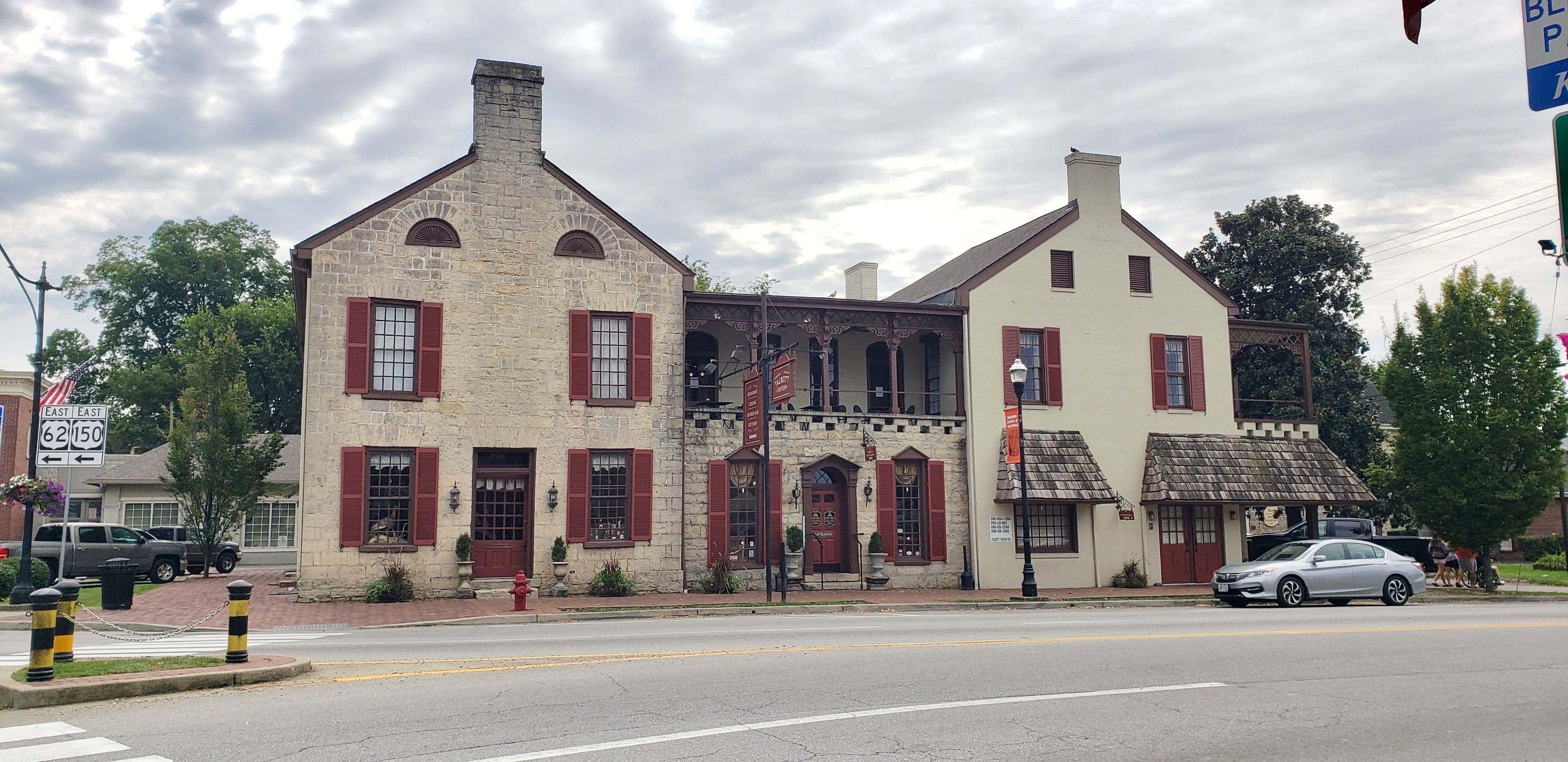 |
 |
There are many reasons to come to Bardstown, but most people who come for one reason end up staying or coming back to explore the others. The town is a state shrine because Pittsburgh songwriter Stephen Foster spent a Summer visiting Judge John Rowan at his 1795 mansion Federal Hill (top photo) and 1200 acre plantation. Foster fell in love with the place and wrote the song My Old Kentucky Home commemorating it. Today the plantation is a state park open for daily tours and the live drama The Stephen Foster Story draws capacity crowds all Summer. Rowan was a prominent figure in his time and everyone of importance, including Presidents, Governors and Congressmen came to Federal Hill to consult on various issues. But Bardstown's place in history predates Federal Hill. The 1779 Talbot Tavern (second photo above) is the oldest inn, restaurant and bar west of the Alleghenies. When Kentucky was still a county of Virginia, the Talbot Tavern saw everyone of importance dropping by. Daniel Boone and George Rogers Clark consulted here on Clark's upcoming western expedition. Authors, artists, businessmen, politicians, European royalty, Presidents, scientists, and even outlaws spent nights here and drank in the bar. Jesse James got drunk and shot holes in a second floor mural. James Fitch designed the steam engine here and built a working model of it in his upstairs room. John James Audubon created a dozen of his famous bird paintings on the upstairs balcony. And you can still stay here, eat here and drink at the bar. The Talbot is the most popular lodging in town. The restaurant still serves the classic Burgoo of the 1700s, although sadly, now instead of the traditional squirrel, rabbit and venison it includes pork, chicken and beef. Perhaps Bardstown's greatest claim to fame is that it's the world Bourbon capitol. 95% of the world's Bourbon is produced in distilleries in town and within a short drive, and they all offer tours and tastings. Individuals or groups doing The Bourbon Trail stay in Bardstown and spend a week touring three distilleries a day. There are 42 tours on the Bourbon Trail, but a week includes 18. Real devotees come back three years in a row to tour all 42, the last few of which are a bit further away so can only be done one a day. Drive out of town in any direction and you'll see the giant rickhouses, the warehouses where barrels of Bourbon age from 5-7 years. As you walk around town, you'll see the big trucks with their loads of Bourbon hauling barrels from the distilleries to the rickhouses or back or from the bottling lines to distant destinations, often overseas. Another reason visitors come to Bardstown is trains. The Kentucky Railway Museum is 13 miles south of town. In addition to its collection of restored engines and cars, the Museum offers a 90 minute passenger train ride through the Rolling Fork River Valley. |
The Old Kentucky Dinner Train is headquartered at the original station in Bardstown, on North Third Street. It operates year round, departing at 6 pm every Friday and Saturday evening. The train travels 32 miles out and back, a trip which takes 2.5 hours. The cars are 1948 passenger cars refurbished. The engines are 1952 diesels, also refurbished. The train sells out most nights, so advance reservations are a must. The trip is most spectacular in October, with the fall foliage, in May, with spring wildflowers and trees budding out, and in Winter just after a heavy snow. However, it's a beautiful and nostalgic experience any time. The tracks go right through the Jim Beam distillery property. At the far end, the engines decouple, come around and couple back on for the return ride. Much of the trip is through forest. When you register for the trip you fill out your menu. Dress is casual classy, meaning ties and heels are not required but buttondowns, sportcoats and dresses are. No crocs, hoodies, spandex or gym clothes. Fedoras are fine but no backward turned baseball caps. You should arrive at 5:15 pm to allow you time to pick up your tickets and find your table. |
|
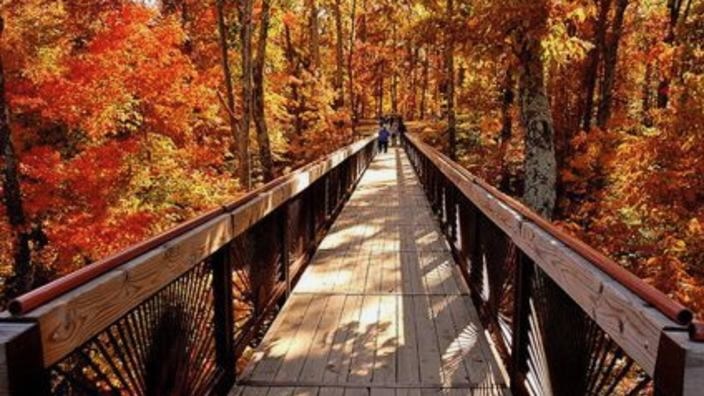 |
Bernheim Forest is a short drive beyond the Jim Beam Distillery, northwest of town. It's a magnificent 16,140 acre preserve purchased in several pieces a century ago by German immigrant and Bourbon distiller Isaac Bernheim. The land had been logged and mined and workers spent 20 years planting 8,000 species of trees, shrubs and wild flowers to create the landscape seen today. It contains a two day backpacking loop, campground, visitor center three lakes, scenic drive, firetower, and cafe (soups, salads, sandwiches, etc.). The Canopy Walk takes you 75 feet above the forest floor so you are literally walking in the treetops. The Forest Giants are a collection of large Danish sculptures (created by Thomas Dambo) set along the hiking trails. Admission is $15 per car but thousands of Kentuckians are members and enter free. Bernheim Forest is especially spectacular in October, as seen at left, but is beautiful year round. |
| A tour of the Kentucky Cooperage is just as fascinating as touring the distilleries. This is where they make the white oak barrels used for aging the Bourbon. You'll see them cut the huge white oak logs into staves, assemble the staves into barrels, and then char them (photo, right). But tours are only by advance reservations; no walk ups are accepted. A tour lasts 45 minutes. No camera can be used. Tours are available at 9 a.m., 11 a.m. and 1 pm. Tickets are $18. Solid leather shoes are required; no open toes, Crocs, sandals, or fabric shoes are allowed. The facility is in Lebanon, 26 miles south, about a half hour drive. | 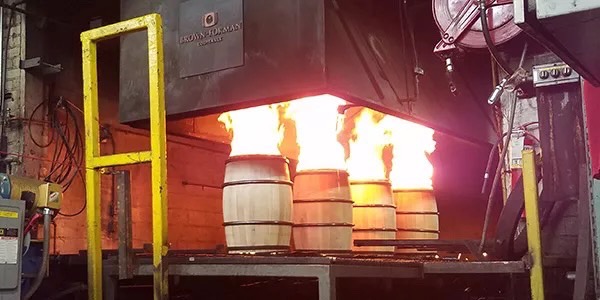 |
.jpeg) |
Catholics find Bardstown a special place. The five county area around Bardstown was settled by Catholics and this is still a heavily Catholic place. In 1808 Pope Pius VII divided the U.S. into four dioceses : Boston, New York, Philadelphia and Bardstown. Benedict Joseph Flaget was placed in charge of this sprawling frontier, stretching from the Gulf to the Great Lakes, thus becoming the "First Bishop Of The Western Frontier." Flaget established schools and churches everywhere. In 1816 construction began on the Cathedral of St. Joseph (left), the first cathedral west of the Allegheny Mountains and oldest standing cathedral in North America. Because of its special historic importance the Pope named it a Basilica. It holds valuable paintings donated by various Popes and European kings. Flaget's original log cabin and the first church, that served until the cathedral could be built, are still intact and available for tours by advance appointment. In 1848 the Abbey of Gethsemani was built by Trappist Monks and is one of the premier monastaries in North America. It has a Welcome Center and gift shop and the interior is open to tours by advance appointment. The Sisters of Charity of Nazareth were founded in 1812 to assist Bishop Flaget in education and health care. They founded academies and colleges which continue to serve the area. The Sisters hold daily services and maintain a Visitor Center and museum. |
| James Fitch was sent to Kentucky to survey the western county of Virginia. He determined that Bardstown was the approximate center of the territory so located here, mostly staying at the Talbot Tavern. While surveying, Fitch laid out 1200 acres for himself just outside town, but his main interest was in designing and building a working steam engine and using it to power a steamboat. He had seen such an engine in England, but England had tight laws prohibiting export of technology, so Fitch had to create one on his own. He built a scale model in his room at the Talbot Tavern, then built a larger one, then went back East, where he obtained patents and the exclusive rights to operate a steamboat for freight and passenger transport on the rivers of New Jersey, New York, Pennsylvania and Delaware. His idea was to hook the "walking beam" of the steam engine to a paddlewheel or several wheels to drive the boat. His steamboat service was a success but he was not a good businessman and he wasn't making money from the business. So he kept returning to Bardstown and surveying the territory. He died in Bardstown and is buried here across the street from the courthouse. A large white tomb marks his grave. After his death, James Fulton perfected the steam engine, became known as its inventor, and became wealthy from it, but it was Fitch who had worked out all the design principles sitting in his room in the Talbot Tavern. | 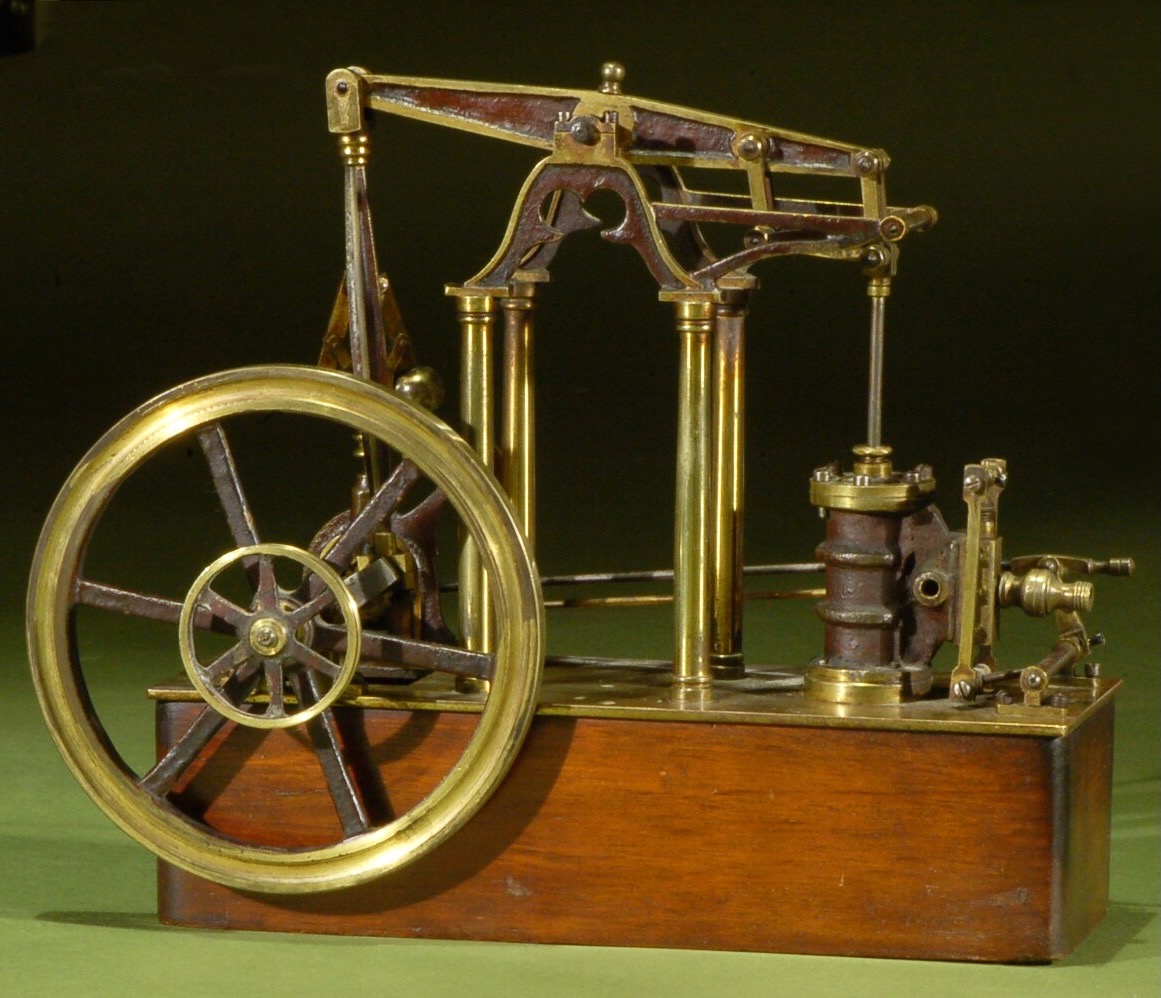 |
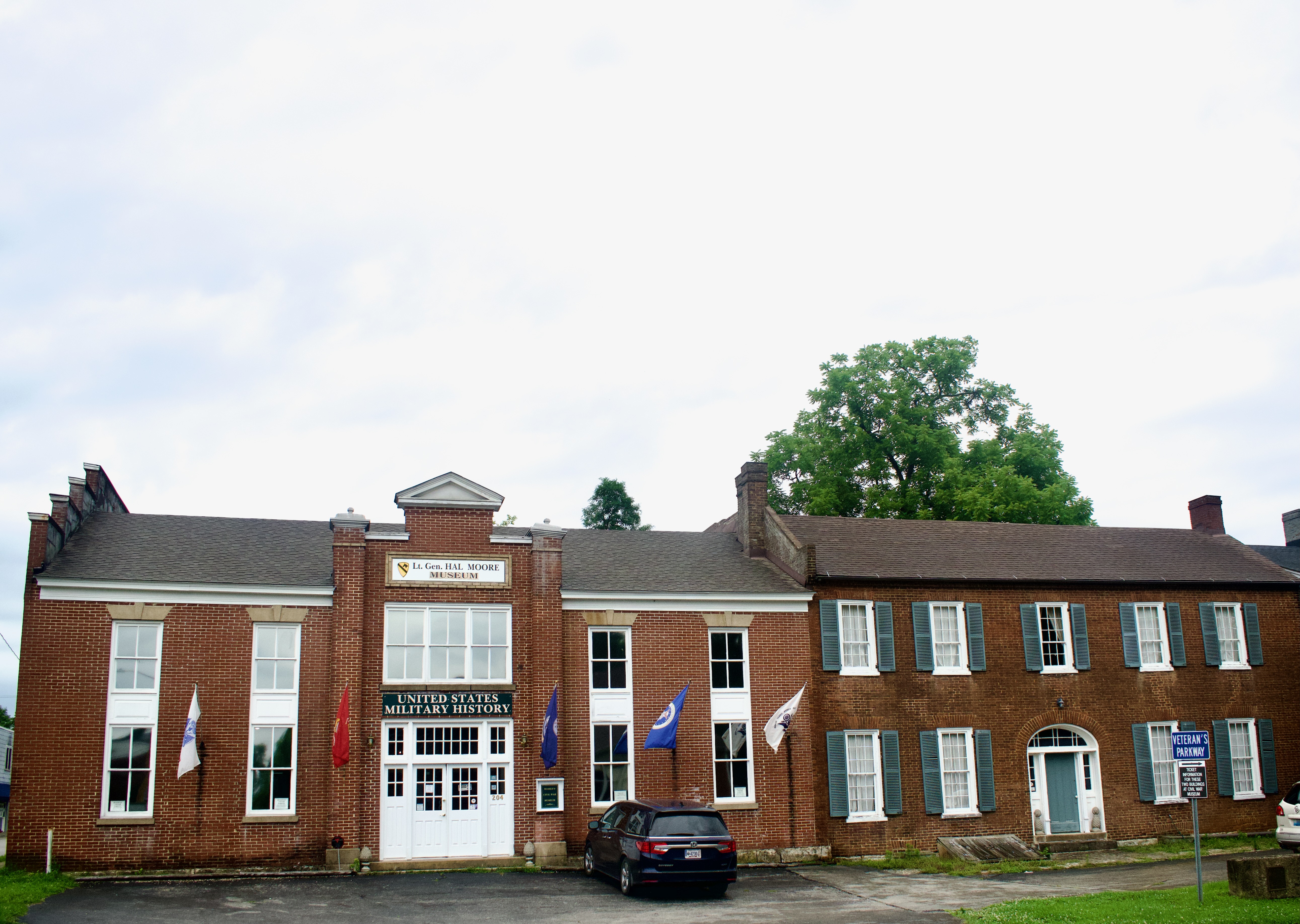 |
Museum Row is a series of museums on Broadway, which runs both directions from North Third Street. This is a really amazing set of museums : The Museum Of The Civil War West Of The Alleghenies, Museum Of Women In the Military, General Hal Moore Museum Of American Military History, Old Bardstown Village, Bardstown and Nelson County Historical Museum, and the Oscar Getz Museum of Whiskey History. Four of them are east of North Third and two are west of it. These are far more than what you might expect from a small town. The Civil War Museum in particular is ranked as one of the finest Civil War Museums in the nation. You will need half a day to work your way through all six collections. The ticket counter is at the Civil War Museum (the furthest east, at the bottom of the hill), and one ticket admits you to the four on that end. Many of the artifacts and original photos here are of such quality and importance that they really belong in the Smithsonian and how they ended up in Bardstown, and have not been claimed by the Smithsonian, is amazing. Even more amazing is how the people of this small town have put together this collection and created these displays without a professional curator, although they did seek advice from several. |
|
|||
|